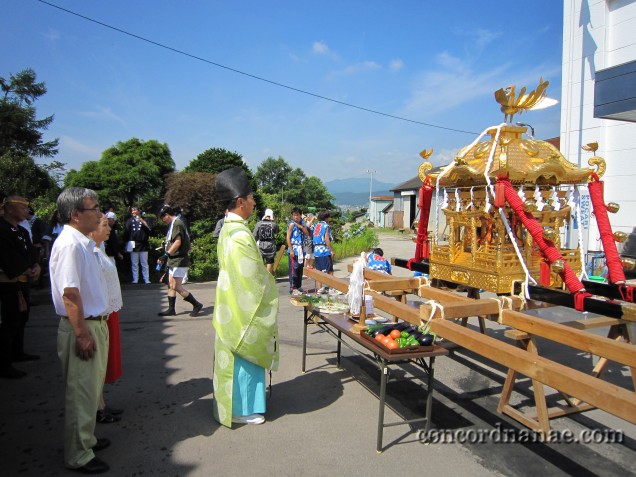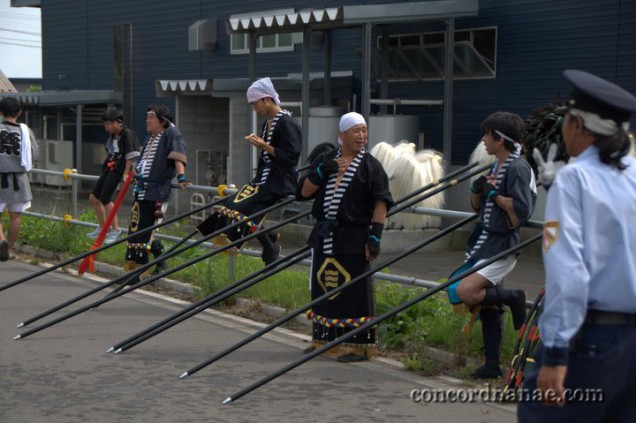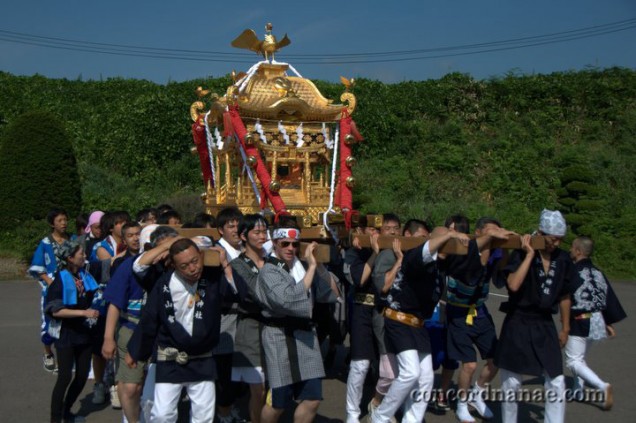
By Ben Mirin, CIR
August 8th, 2011
Nanae’s new Assistant Language Teacher (ALT) and Concord native Ben Haydock arrived sweaty and exhausted at Hakodate airport on July 28th. He had a full week of festivities for the Hakodate Port Festival to look forward to, but his true initiation as a member of the Nanae community would not come until the following week.
Five hundred pounds, dripping with golden chains and clamoring bells, Nanae’s O-Mikoshi (mobile shrine) emerges from the stores of Nanae’s Mishima Shrine only once a year, on the shoulders of two-dozen men. At 7:30am on August 8th, Ben and I suited up in traditional happi robes and joined twenty other local volunteers to carry this cherished relic up and down the streets of Nanae for the town’s annual Summer Festival.
“After dancing the Ika Odori (squid dance) in the Hakodate Port Festival, I didn’t entirely know what to expect from Nanae the following week “ Ben said.
“I knew we would be carrying something heavy, but it wasn’t until we started down the street, with the O-Mikoshi in tow, that I realized my role in this festival was more as a laborer than as a carefree festival goer.”
O-Mikoshi all over Japan travel annually among the neighborhoods that worship at the Shinto shrines where they are kept year round. They serve as vehicles for particular Japanese Shinto deities, traditionally believed to reside in the principle shrines themselves. As they are bourn along the avenues of their respective districts, the O-Mikoshi spread good fortune to deferential residents who emerge from their homes and shops to pray and offer donations that support the festival for the following year.

That day our task was to cover all of Honcho, a district in Nanae that proved far larger than either Ben or I had imagined. At eight o’clock sharp, we shuffled into place around the O-Mikoshi’s wooden supports and prepared to march as five pairs of Yakko, or fan-bearers, took their places at the front of the procession. They carried long staves capped with masses of decorative feathers. Two by two they stepped forward and, swooping down to a crouch, swung these ornaments low over the ground with choreographed precision. They were clearing a path for our shrine to travel.

The last of the Yakko moved off, repeating their ritual every few meters. The veteran marchers began shaking the O-Mikoshi enthusiastically to set the mood for the festive procession. This continued for several minutes until a shout came from the front of the group. As one we hoisted the O-Mikoshi over our heads and marched forward from beneath the shade of Mishima’s iconic curving rooftop.

The heat was overwhelming. By lunchtime Ben and I could barely keep upright over our hearty lunches of o-nigiri (rice balls), fried chicken and beer back at the Mishima grounds. We had already been pressed to imbibe adult beverages at several stops along the way. As local priests presided over the shrine and patrons presented offering of fresh produce and sake, our group had converged on prepositioned coolers of mostly Asahi and Sapporo malts. Now exhausted and drenched with sweat, we fell asleep spread-eagled on Mishima’s polished wooden floor.

I woke with a start as a group of student volunteers kicked over a tower of empty beer cans. They were rushing back to the O-Mikoshi. It was time for another march.
Eight hours later our ranks had thinned. Several of the high school volunteers had been called away to their part-time jobs, and a few of the older shrine-bearers had quietly excused themselves from the parade. We had one final push to make: as festivalgoers were amassing along Mishima’s main walkway amidst food stands and carnival games, we gathered at the gates below. The signal came, and we charged forward, chanting with renewed vigor and heaving the O-Mikoshi along to its final resting place at the top of the hill.
“Did you see the pieces falling off the O-Mikoshi on that final stretch?” Ben asked breathlessly as our fellow marchers exchanged high-fives.
We grabbed plates of takoyaki and sat down on Mishima’s cement steps while the energy of our final performance was still reverberating through the crowd.
“We marched a total of thirteen hours today, but in the midst of such a strong showing from the Nanae community, it all feels worthwhile. I feel initiated.”♦
Please consider leaving a comment on this post in the comment section below, or subscribing to the RSS feed to have future articles delivered to your feed reader.
To submit suggestions for future content, please email concordnanae@gmail.com. Thank you for visiting ConcordNanae.org.

